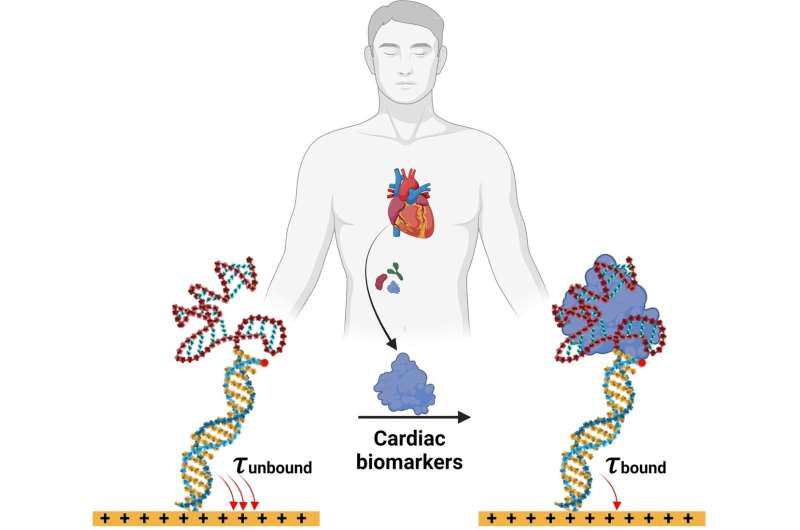This article has been reviewed according to Science X's editorial process and policies. Editors have highlighted the following attributes while ensuring the content's credibility:
fact-checked
peer-reviewed publication
trusted source
proofread
Electronic biosensor uses DNA aptamers for detecting biomarkers in whole blood samples

A team of researchers has developed an electronic biosensor based on DNA aptamers that can detect biomarkers in whole blood samples without the addition of reagents. As the team explains in the journal Angewandte Chemie International Edition, the DNA aptamers recognize marker proteins as efficiently as antibodies do, but are easier to prepare and more adaptable. The biosensor was able to detect clinically relevant levels of a marker protein for cardiovascular disease without any further sample preparation.
Researchers aim to develop diagnostic tools that can detect disease biomarkers directly, reliably, and in the field, without the need to send samples to specialized laboratories for analysis. Shana O. Kelley of the University of Toronto, Canada, and Northwestern University in Evanston, IL, U.S., and her team have developed a simple chip-based device to detect marker proteins in complex samples using chronoamperometric measurements.
Their nanoscale sensor system works as a molecular "pendulum": it measures the extra load a protein places on the pendulum, which consists of a strand of DNA tethered to an electrode. The approach does not require any external reagents.
Typically, antibodies are used to seek out and bind marker proteins in complex mixtures. However, antibodies are themselves proteins, and as such are quite complex to design and produce. Kelley and colleagues have now found that the smaller and simpler DNA aptamers can be used instead of antibodies. DNA aptamers are short synthetic fragments of with specific shapes and structures. They are relatively easy to make and, with customizable structures, cheaper to produce than antibodies.
Like antibodies, DNA aptamers can bind marker proteins through molecular and structural interactions, but they are easier to design. "DNA has the most predictable and programmable interactions of any natural or synthetic molecule," explain Kelley and her team. To develop an aptamer-based sensor, they created a DNA aptamer that specifically detects B-type natriuretic peptide (BNP), a biomarker for cardiovascular disease, and linked this aptamer with the DNA pendulum strand tethered to the gold electrode to create the molecular pendulum sensor.
The completed biosensor successfully detected BNP, even in complex mixtures such as unprocessed whole blood from cardiac patients. Because Kelley and colleagues found that the sensitivity of the aptamer-based system was as high as that of antibody-based detection, they suggest further research and use of DNA aptamers for laboratory-independent diagnostics.
More information: Alam Mahmud et al, Monitoring Cardiac Biomarkers with Aptamer‐Based Molecular Pendulum Sensors, Angewandte Chemie International Edition (2023). DOI: 10.1002/anie.202213567
Journal information: Angewandte Chemie International Edition
Provided by Wiley





















